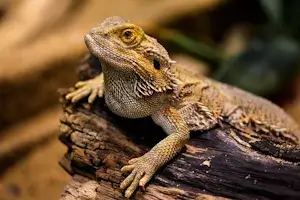A Comprehensive Guide to Bearded Dragon Care
Bearded dragons, native to Australia, are among the most popular reptiles for terrarium enthusiasts. Their friendly nature, low-maintenance requirements, and intriguing behavior make them ideal pets for beginners and experienced reptile keepers alike. This article provides a step-by-step guide on how to care for bearded dragons properly—from choosing the right terrarium to nutrition, care, and health management.
1. What Are Bearded Dragons?
Bearded dragons are lizards from the Agamidae family. The most well-known species is Pogona vitticeps, commonly referred to as the central bearded dragon. These fascinating reptiles have unique characteristics:
- The Beard: A spiky throat they puff out when stressed or threatened.
- Behavior: They are diurnal, curious, and often interact with their keepers.
- Size: Bearded dragons grow to 16–24 inches (40–60 cm), with the tail comprising about half of their length.
2. The Terrarium: Creating the Ideal Habitat
Terrarium Size
The size of the terrarium is crucial for the well-being of your bearded dragon:
- For one adult dragon: Minimum of 48 × 24 × 24 inches (120 × 60 × 60 cm).
- For multiple dragons: Larger enclosures are necessary to provide enough space.
Terrarium Setup
- Substrate: Sand-clay mixes mimic their natural habitat and allow digging.
- Climbing Elements: Branches, rocks, and platforms create climbing opportunities and temperature gradients.
- Hiding Spots: Caves or shelters provide a sense of security.
Lighting and Temperature
- UVB Lamps: Essential for Vitamin D3 production and preventing bone diseases.
- Heat Spots: Basking areas should reach 104–113°F (40–45°C).
- Temperature Zones: Daytime temperatures should range from 75–86°F (24–30°C), with nighttime temperatures dropping to 64–72°F (18–22°C).
Humidity
- Low Humidity Levels: Maintain 30–40% humidity.
- Regular Monitoring: Use a hygrometer to ensure proper levels.
3. Nutrition: What Do Bearded Dragons Eat?
Bearded dragons are omnivores and require a balanced mix of animal and plant-based foods.
Plant-Based Diet
- Greens: Arugula, dandelion, endive.
- Vegetables: Carrots, zucchini, bell peppers.
- Fruits: Occasionally, small amounts of apples or berries.
Animal-Based Diet
- Live Insects: Crickets, locusts, roaches, or mealworms.
- Juveniles: Require more animal protein—80% animal, 20% plant-based.
- Adults: Switch to 80% plant-based, 20% animal protein.
Supplements
- Calcium: Use calcium supplements to support bone health.
- Vitamins: High-quality vitamin supplements, especially those with D3.
Feeding Frequency
- Juveniles: Feed daily.
- Adults: Offer plant-based food daily and animal protein 2–3 times a week.
4. Behavior and Socialization
Typical Behaviors
Bearded dragons are diurnal and spend much of their time basking, climbing, or exploring their environment. They communicate through body language, such as head bobbing or waving.
Socialization
- Solo Housing: Preferred, as bearded dragons are territorial.
- Multiple Dragons: If housing together, keep females—males may exhibit aggression.
5. Terrarium Maintenance and Cleaning
A clean terrarium is vital for your bearded dragon’s health.
Daily Maintenance
- Remove feces and uneaten food.
- Check temperature and humidity levels.
Weekly Maintenance
- Clean water and food bowls.
- Replace soiled substrate as needed.
Deep Cleaning
- Every 4–6 weeks, remove all substrate, clean the terrarium accessories, and disinfect the enclosure.
6. Health Care for Bearded Dragons
Common Health Issues
- Metabolic Bone Disease (MBD): Caused by insufficient UVB lighting or calcium deficiency.
- Parasites: Often introduced via contaminated food or poor hygiene.
- Heat Stress: Symptoms include lethargy or hiding in cooler areas.
Prevention
- Replace UVB bulbs every 6–12 months.
- Provide a balanced diet and appropriate temperature levels.
- Schedule regular fecal exams with a reptile vet.
7. Winter Brumation in Bearded Dragons
Bearded dragons undergo a form of hibernation called brumation.
Preparation
- Gradually reduce lighting and temperature over several weeks.
- Avoid feeding for 1–2 weeks beforehand to clear their digestive tract.
During Brumation
- Maintain temperatures between 50–59°F (10–15°C).
- Bearded dragons will remain mostly inactive and won’t eat.
Post-Brumation
- Slowly increase lighting and temperatures.
- Reintroduce food in small portions.
8. Are Bearded Dragons Right for You?
Bearded dragons make excellent pets for reptile enthusiasts who are committed to meeting their unique needs. They require consistent care, a thoughtfully arranged habitat, and dedication but offer a rewarding experience and a lifespan of 10–15 years.
Conclusion: Proper Care for a Happy Life
Bearded dragons are fascinating and rewarding pets that thrive with proper care. From terrarium setup to nutrition and health management, ensuring their needs are met will allow them to live a healthy and happy life. With the right preparation, you can enjoy exploring the captivating world of bearded dragons.

